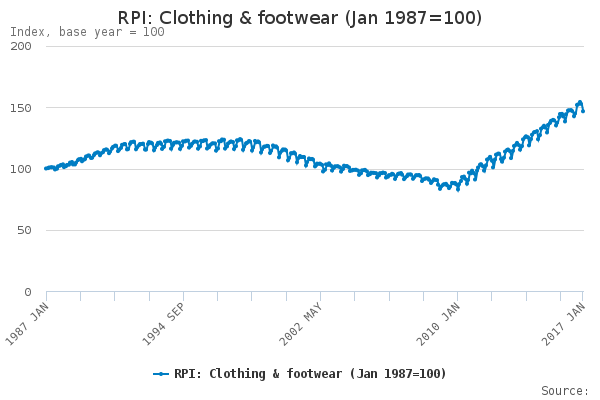

One reason why it may look more attractive to bring back some on shore manufacturing is the recent increase in the retail price index for clothing and footwear. Back in January 2010 after more than ten years of flat and falling retail prices the RPI was equivalent to 82 per cent of that in 1987.Five years on in May 1992 the RPI stood at 97% of what it was in 1987. Effectively meaning average prices were moving towards but had not reached what they were five years earlier. In December 2016 average retail prices stood at 1.52 times what they were in 1987.
In the late 1980’s as average retail prices fell, retail clothing and footwear buyers began to search for ways to lower their costs to remain competitive and in order to compete in a market where prices were falling. These price falls caused by changing economic circumstances, coincided with shifts in consumer tastes and fierce retail competition led them to source and produce much more of their offering offshore. The percentage of goods imported rose steadily. In the UK this initially meant moving to lower cost supplies in Portugal and North Africa. As the RPI continued to fall the search intensified for global suppliers located in lower labour cost countries able to manufacture and ship goods at cost prices that would enable retailers to maintain or improve their profit margin despite the fall in average retail prices. The graph shows a turning point in January 2010 where the RPI has steadily increased from 87.2 to 152.8 in December 2016. There has been a slight downturn in January 2017 but there is a continuing upward trend. Put this alongside the 17-20% fall in sterling exchange rates against the dollar since July 2016 making the price of imported goods and services higher it means there is scope for re-evaluating sourcing and manufacturing commitments for some clothing and footwear lines.
The economic benefits of the shifting cost base make it more attractive to develop and retain some skilled manufacturing in the UK close to market demand. This gives retailers more flexibility in terms of response times to catch fashion trends. It also creates jobs, reduces imports and benefits the balance of payments deficit in clothing and footwear.This does not mean on-shoring will replace off-shoring which has grown rapidly since the 1980s, but it does mean there is scope to change the balance of sourcing costs now that variables in the equation are shifting.
© 2017 Tony Hines
If you want to cite this article please acknowledge the author and the work as follows:
Hines,T (2017), The Business of UK Fashion, tonyhinesblog.wordpress.com